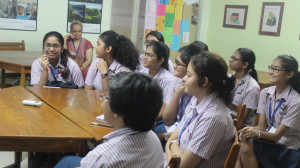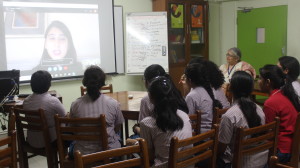‘Have you ever met or spoken to anyone from Pakistan?’
‘Yes!’
‘So, what comes to mind when you think about Pakistan?’
‘Jinnah!’
‘The flag!’
‘A sudden patriotism during cricket matches!’
‘What comes to mind when you think about Bangladesh?’
‘Bangal and Ghoti!’
‘Cultural difference!’
‘Ilish!’
‘You really have to explain that to me,’ said a slightly perplexed Anam to the ten excited students in front of her.
The Skype conversation between Anam Zakaria, author, educationist and development professional, and students from Modern High School for Girls (classes 11 &12) took place on 18July 2018.
This was not the first time that the students were speaking to someone across the border—many were acquainted with, and some had formed strong friendships with Pakistanis and Bangladeshis through various exchange programmes, camps and conversations over social media. They were eager to speak with Anam and put forward their opinions about the history of the subcontinent and the ideas that continue to exist about the Other in present day India.
The girls were highly aware of the events that unfolded around the 1947 Partition. Their knowledge of the 1971 Partition was gleaned more from their own family histories than their academics. While their textbooks provide little material about the 1971 war, they are aware about 1971 because of the cultural allusions to it and their own research on the internet. They believe that the 1947 Partition happened because the political leadership could not come to an agreement, not because of existing communal strife. They blame communal strife squarely on the Divide and Rule policy of the British. The students believe that the 1971 partition happened because of the physical presence of India between East Pakistan and West Pakistan, which caused administrative issues, with the Urdu/Bangla language divide exacerbating the situation. They believe that India’s involvement in the 1971 war was ‘a necessary evil’ because the Bangladeshis were not equipped with defenses that could contend with the power of the West Pakistani state.
The students were highly critical of the one-sided narratives which they find in their textbooks about the partition and insisted that there are always two sides to a story. They opined that their textbooks provided them with limited facts which came in the way of forming a well-rounded opinion. Many of them have relatives who were affected by either of the partitions and shared stories of the violent past endured by their families. Some of them have even done oral history projects on the partitions, documenting the narratives of their older generations. The girls insisted on looking at these inherited memories of violence in the wider context of the politics of the time. They shared how their previous generations refuse to discuss the partitions beyond the memories of violence and how their parents are reluctant to accept their own friendships with Muslims: Pakistanis and Bangladeshis. They accepted that their initial conversations with their friends from Pakistan and Bangladesh were coloured by the presumptions they had made about one another. But that these ill-informed ideas soon made way to the realization that we are, at the end of the day, not very different from each other. The students suggested that while they understand the extreme ideas that the older generations have about the Other because of their own experiences, they themselves are situated at a distance from the events and can now assess these experiences in light of the wider political context.
They had a number of questions for Anam: What do Pakistanis really think about Indians? Has she visited Mohenjo-daro and Harappa? How much does she think the Pakistani curriculum and government narratives influence them?
Anam shared that while most of country still harbours a hostile sentiment towards India, she has seen the tide change with some of the younger generation who have interacted with people from across the border. That there are Pakistanis who have roots in India and who very much want to learn more about their own histories. But she has also found a concretization of hate towards Indians in the younger generations who have not interacted with the Other but have only imbibed the narratives passed down through the generations in their family. She thinks that the government narratives and the prevalent curriculums go a long way in shaping the mindsets of individuals but that as the girls shared with her, interactions with real people often change the narrative. And that while she has visited Harappa, she is yet to make her way to Mohenjo-daro.
It was heartening to see that the children were conscious of the possibilities of multiple narratives in history, that they critically assess the narratives presented to them in their curriculum. That they are open to interact with, understand, learn from and form friendships with people from across the border. That they are open to change.
– Anushka Halder
1971 in Classrooms is a series of conversations between Pakistani author Anam Zakaria and high school students in Calcutta.


